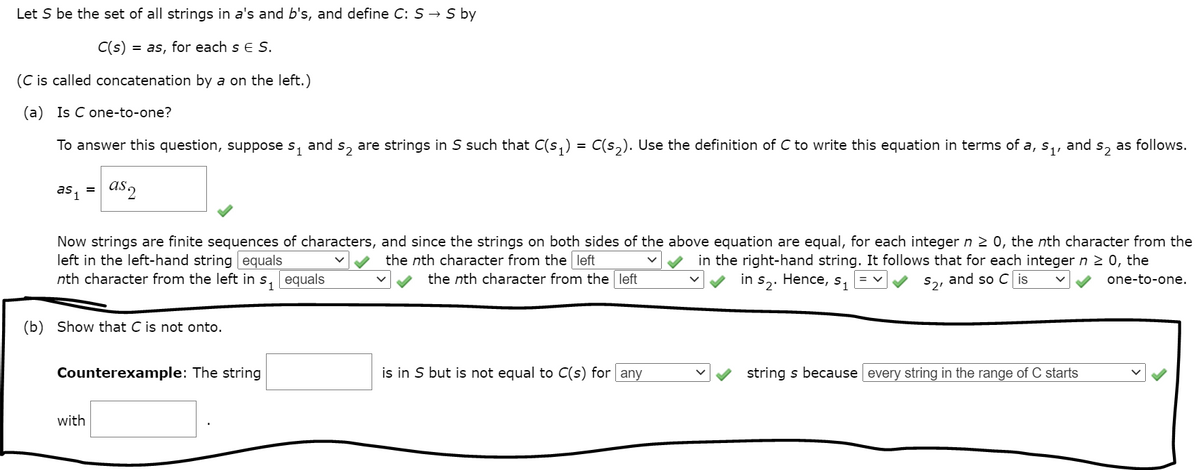Let S be the set of all strings in a's and b's, and define C: S → S by C(s) = as, for each s ∈ S. (C is called concatenation by a on the left.) (b) Show that C is not onto. Counterexample: The string _____ is in S but is not equal to C(s) for any string s because every string in the range of C starts with _____.
Let S be the set of all strings in a's and b's, and define C: S → S by C(s) = as, for each s ∈ S. (C is called concatenation by a on the left.) (b) Show that C is not onto. Counterexample: The string _____ is in S but is not equal to C(s) for any string s because every string in the range of C starts with _____.
Elements Of Modern Algebra
8th Edition
ISBN:9781285463230
Author:Gilbert, Linda, Jimmie
Publisher:Gilbert, Linda, Jimmie
Chapter5: Rings, Integral Domains, And Fields
Section5.2: Integral Domains And Fields
Problem 7E: [Type here]
7. Let be the set of all ordered pairs of integers and . Equality, addition, and...
Related questions
Question
Let S be the set of all strings in a's and b's, and define C: S → S by
C(s) = as, for each s ∈ S.
(C is called concatenation by a on the left.)
(b) Show that C is not onto.
Counterexample: The string _____ is in S but is not equal to C(s) for any string s because every string in the range of C starts with _____.

Transcribed Image Text:Let S be the set of all strings in a's and b's, and define C: S → S by
C(s)
= as, for each s E S.
(C is called concatenation by a on the left.)
(a Is C one-to-one?
To answer this question, suppose s, and s, are strings in S such that C(s,) = C(s,). Use the definition of C to write this equation in terms of a, s,, and s, as follows.
ds, =
as2
Now strings are finite sequences of characters, and since the strings on both sides of the above equation are equal, for each integer n 2 0, the nth character from the
left in the left-hand string equals
nth character from the left in s,
in the right-hand string. It follows that for each integer n 2 0, the
in s2. Hence, s.
the nth character from the left
equals
the nth character from the left
S21
and so C is
one-to-one.
(b) Show that C is not onto.
Counterexample: The string
is in S but is not equal to C(s) for any
string s because every string in the range of C starts
with
Expert Solution
This question has been solved!
Explore an expertly crafted, step-by-step solution for a thorough understanding of key concepts.
This is a popular solution!
Trending now
This is a popular solution!
Step by step
Solved in 2 steps

Knowledge Booster
Learn more about
Need a deep-dive on the concept behind this application? Look no further. Learn more about this topic, advanced-math and related others by exploring similar questions and additional content below.Recommended textbooks for you

Elements Of Modern Algebra
Algebra
ISBN:
9781285463230
Author:
Gilbert, Linda, Jimmie
Publisher:
Cengage Learning,

Elements Of Modern Algebra
Algebra
ISBN:
9781285463230
Author:
Gilbert, Linda, Jimmie
Publisher:
Cengage Learning,